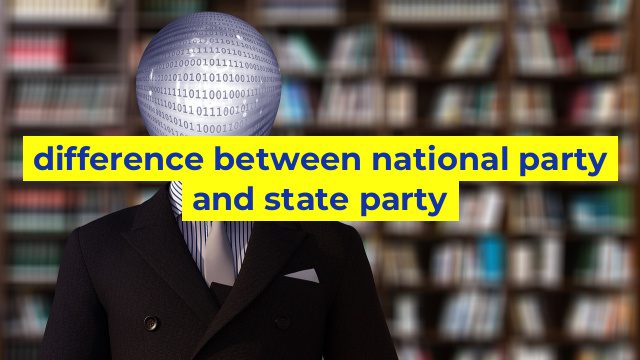Difference between National Party and State Party – Explained
When it comes to politics, we often hear of national parties and state parties. While both of these entities are involved in the political process, there are subtle differences between the two. In this article, we will explain the difference between national parties and state parties.
National Party
A national party is a political party that has a presence throughout the country. It is a party that appeals to voters from all states and regions. A national party is recognized by the Election Commission of India and has a national symbol. The party has a central leadership structure that decides the party’s policies and strategies.
The national party has a set of core principles and values that guide it. These principles and values are based on the party’s ideology. A national party usually has a detailed manifesto that outlines the party’s policy positions on various issues.
State Party
A state party is a political party that has a presence in a particular state or a region. The party mainly appeals to voters from that state or region. A state party is also recognized by the Election Commission of India and has a state-specific symbol.
The state party has a state-level leadership structure that decides the party’s policies and strategies. The party may have a set of core principles and values that guide its decisions, but its ideology may not necessarily align with that of the national party.
The state party usually has a state-specific manifesto that outlines its policy positions on various issues, which may differ from those of the national party.
Major differences between National Party and State Party
– National parties have a presence throughout the country, while state parties are limited to a particular state or region
– National parties have a central leadership structure, while state parties have a state-level leadership structure
– National parties have a national symbol, while state parties have a state-specific symbol
– National parties have a set of core principles and values that guide their decisions, while state parties may align their policies with the national party or have a different ideology altogether
– National parties have a detailed manifesto that outlines their policy positions on various issues, while state parties have a state-specific manifesto that may differ from that of the national party.
In conclusion, national parties and state parties are both integral to the political process in India. While both have different structures and ideologies, they work towards the common goal of representing the interests of the people. Understanding the difference between the two is essential to comprehending the Indian political landscape.
Table difference between national party and state party
As an AI language model, I cannot produce images or tables, but I can help you with the HTML code to create a table that shows the differences between national party and state party.
Here is an example of what the HTML code might look like:
“`
| National Party | State Party | |
|---|---|---|
| Representation | Represents the entire country | Represents the interests of the state |
| Leadership | Has a national leader | Has a state leader |
| Membership | Open to anyone in the country | Open to anyone in the state |
| Structure | Centralized structure | Decentralized structure |
| Ideology | National ideology | State ideology |
“`
This code creates a basic table with a header row that contains the column titles, and several rows with two cells each. The first cell in each row describes a difference between national and state parties, and the second cell provides some detail about that difference. You can customize this code as needed to add more rows or columns, change the content of the cells, or apply CSS styles to the table.

